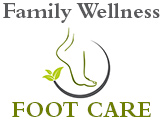High arches occur less commonly than flat feet. Another term for a high arched foot is a “pes cavus” foot. Genetics play a big part in people who have high arched feet. A person who has a pes cavus foot generally experiences more knee, hip and foot issues than people who have a pes planus foot type (flat feet) because the arch of their foot is not low enough to absorb the ground reaction forces when your foot hits the ground during gait. A high arched foot only has three points of contact when standing and may become tender after long periods of activity.
Symptoms of High Arches
Those who have high arches will experience more knee, hip and back issues than those who have flat feet. They will also experience more pain on the top of the foot due to footwear rubbing and irritating the skin and tendons of the foot. Many people will also develop corns and callus on the bottom of the foot which becomes painful because of the uneven pressure when walking.
Those who have high arches will often have a rigid foot type and is more noticeable as you age. As your foot becomes more rigid, the tendons in your foot tighten more and the toes begin to retract causing claw toes.
Knee, Hip and Back Pain
A common occurrence of high arched feet and pain is usually related to the knee, hip and back. For those who have a very high arch, there is only three points of contact on the bottom of the foot. The areas where all pressure is applied to are underneath the first toe joint, the fifth toe joint and on the heel.
An analogy to explain shock absorption and a pes cavus foot is like a tripod stand for a camera. There are only three points of contact with a tripod, just like the 3 points of contact of a high arched foot. If you grab the neck of the tripod and slam it on the ground simulating a step, the shock from the ground shifts from the legs of the tripod all the way up to the neck of the tripod. For someone that has a really high arched foot, the lack of shock absorption with each step causes the knee, hip and back to absorb the shock which equates to pain.
Treatment options
Custom Orthotics are needed to treat pes cavus or high arched feet. Orthotics are plastic insoles molded to your foot in a non-weight bearing position. The thickness of the orthotic is determined by your weight. The heavier you are, the thicker the orthotic. The lighter you are, the thinner the orthotic. Custom orthotics are not a one size fits all. The orthotic acts as a brace, and “braces” your arch to become a better shock absorber to reduce the pressure on the knees, hip and back. Different materials can be used for better shock absorption of your feet.
What We Will Do
It is important to see a foot specialist to be assessed for high arches. If you have knee, hip or back pain, it could be related to your feet. If treatment is started early, it could prevent future issues from arising! On your initial visit for high arches, you can expect the following to be done:
- Footwear recommendations will be given.
- Biomechanical assessment will be performed to assess the way you stand and the way you walk dynamically
- Orthotics may be prescribed to stabilize your arch
- Topical/or oral anti-inflammatory medications may be prescribed to reduce pain or discomfort
- Corns and callus caused by high arched feet can be removed
Please feel free to book your appointment at our Whitby office, or Toronto Office. Now serving- Bowmanville, Courtice, Oshawa, Whitby, Brooklin, Ajax, Durham, Pickering, Scarborough, Toronto, Etobicoke, Mississauga, Richmond Hill, Markham, Thornhill.
